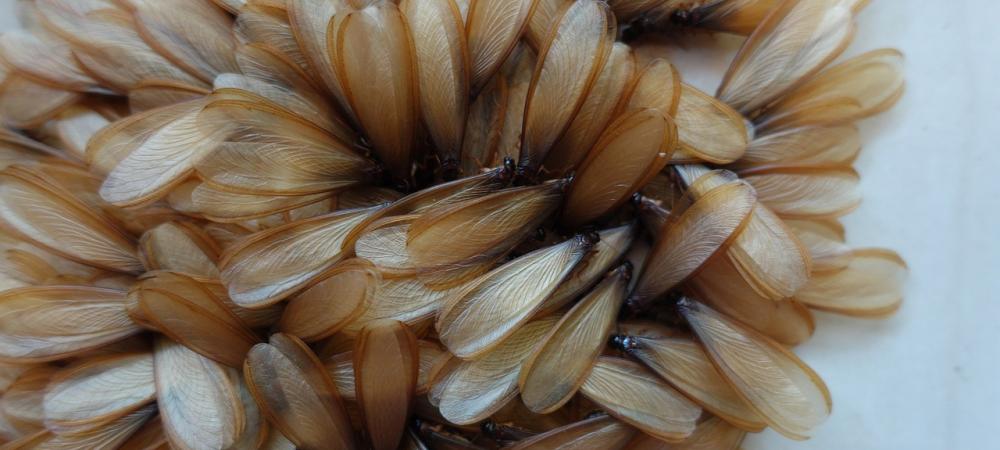Seeing a swarm of winged insects inside or around your home can be one of the more stressful moments for a property owner. Your mind immediately jumps to the worst-case scenario. The crucial question you need to answer is: are you dealing with termites or flying ants?
While they can look deceptively similar, the difference between them is monumental. One is a temporary natural event, while the other is a clear and present threat to your home's structure and value. This guide provides a definitive, 3-step process to help you tell them apart with certainty.
Urgent First Check: Know the Threat Level
Termites (HIGH THREAT): These are "swarmers" from a wood-destroying colony. Their presence demands immediate attention. They have a broad waist, straight antennae, and four wings of equal size.
Flying Ants (LOW THREAT): These are "alates" from a nearby ant nest. They are a temporary nuisance and not a structural danger. They have a pinched waist, bent antennae, and two unequal pairs of wings.
[Here: A pest control professional demonstrates the physical differences between a termite swarmer and a flying ant, holding them side-by-side.]
The Critical Difference: Nuisance vs. Nightmare
The fundamental difference between these two insects comes down to their diet and purpose.
Flying ants are on a "nuptial flight." They have left their nest to mate and start new colonies, typically in soil outdoors. They do not eat wood and are not interested in the structure of your house.
Termites, on the other hand, are a direct extension of a colony that actively consumes cellulose, the primary component of the wood that holds up your home. As the U.S. Forest Service warns in its literature on wood-destroying insects, a termite swarm is a sign that a mature colony is nearby and looking to expand its territory.
The 3-Step Identification Guide: Termites vs Flying Ants
To make a positive identification, you only need to look closely at three key features.

Caption: For a confident ID, always check the waist, antennae, and wings.
1. Check the Waist: Broad vs. Pinched
Termite: The termite has a thick, rectangular body with no visible waist. Its thorax and abdomen are broadly connected.
Flying Ant: The ant has a clearly defined, narrow, "pinched-in" waist, creating the classic hourglass shape that separates the main body segments.
2. Check the Antennae: Straight vs. Bent
Termite: The termite has antennae that are completely straight and can look like a tiny string of beads.
Flying Ant: The ant has "elbowed" antennae, meaning they are distinctly bent in the middle.
3. Check the Wings: Equal vs. Unequal
Termite: The termite has four wings that are all equal in length and shape. They are often translucent and significantly longer than the insect's body.
Flying Ant: The ant has four wings that are unequal in size. The front pair of wings is noticeably longer than the back pair.
Look for Corroborating Evidence
If you suspect termites, look for these other classic signs that confirm an infestation.
Discarded Wings: This is often the most obvious evidence. After swarming, termites shed their wings. Finding piles of these identical, shed wings on windowsills or floors is a strong indication of their presence.
Mud Tubes: Subterranean termites build mud tunnels the width of a pencil to travel from the soil to the wood in your home. Check your foundation, subflooring, and crawl spaces for these distinctive earthen lines. According to the University of California's Agriculture and Natural Resources program, these tubes protect termites from dehydration.

Caption: Finding piles of identical, shed wings is a major red flag for a recent termite swarm.
Your Action Plan Based on Identification
Your response should be swift and appropriate to the insect you've identified.
If You Have Confirmed TERMITES...
Don't Panic, But Act Fast. While the damage is not done overnight, a swarm indicates an active colony that needs to be addressed.
Collect a Sample. If possible, place a few of the insects or their wings in a sealable bag or jar for a professional to examine.
Call a Certified Professional Immediately. This is not a DIY problem. A licensed pest control company is needed to perform a thorough inspection, determine the extent of the infestation, and recommend a treatment plan.
If You Are Sure They Are Flying ANTS...
Relax, Your Home is Safe. The swarm is a temporary event.
Clean Up. Use a vacuum cleaner to remove any ants inside your house.
Seal Entry Points. After the swarm is over, check for and seal any cracks or holes the ants used to get in.
In the crucial comparison of termites vs flying ants, accurate identification is everything. Don't leave it to chance. A few minutes of careful observation can save you from unnecessary stress or a major home repair bill. When in doubt, always trust a professional inspection.
